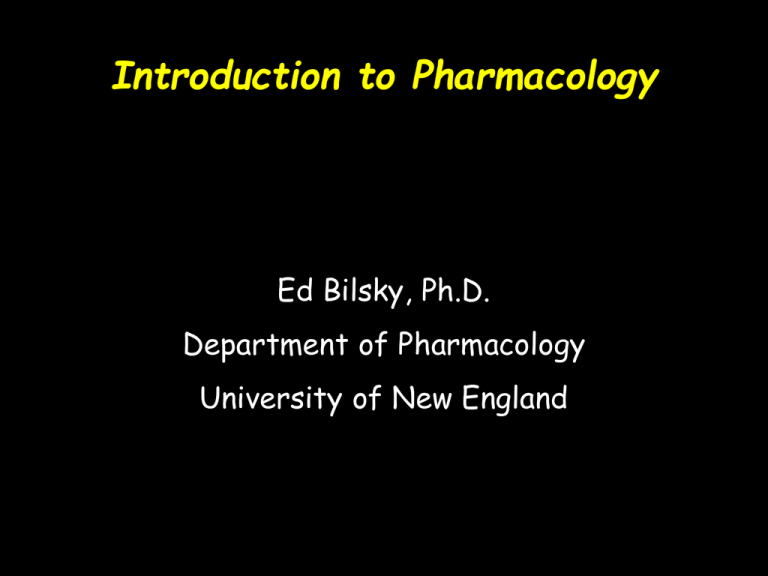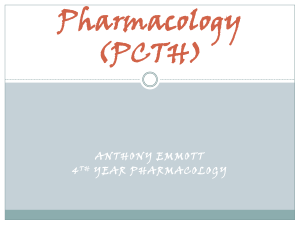Introduction to Pharmacology
advertisement

Introduction to Pharmacology Ed Bilsky, Ph.D. Department of Pharmacology University of New England What is Pharmacology? • Pharmacology is the study of what drugs do and how they do it – toxicology is a related field that deals with the undesirable effects of chemicals on living systems, from the cellular level up to whole ecosystems • A knowledge of pharmacology is essential for using drugs safely and effectively in therapy • Pharmacology has had, and continues to have, an enormous impact on society Study: Old drugs might give TB a 1-2 punch Feb 26, 2009 By LAURAN NEERGAARD WASHINGTON (AP) - Scientists might have found a way to deal drug-resistant tuberculosis a one-two punch using two old, safe antibiotics - and studies in ill patients could begin later this year. TB is one of the world's oldest killers, and the lung disease still claims the lives of more than 1.5 million people globally every year. The bacteria that cause TB are fast becoming impervious to many treatments, drug resistance that is seen worldwide but is a particular problem in parts of Asia and Africa. While typically the TB doesn't respond to two top treatments, an emerging threat is so-called extensively drug-resistant disease, or XDR-TB, that is virtually untreatable by remaining options. So researchers are frantically hunting new approaches, including taking a fresh look at some old drugs. The combo: Clavulanate to drop TB's shield, plus a long-sold injected antibiotic - meropenem, part of that penicillin-style family - that then attacks the bacteria. What happens in a lab doesn't necessarily work in people. Still, the findings were so compelling that two teams of U.S. researchers - from the National Institutes of Health and New York's Montefiore Medical Center - already are planning small patient studies in South Korea and South Africa. They hope to begin those studies later this year. Definitions • Pharmacodynamics is the study of the effects of the drug on the organism – Molecular mechanisms --> clinical response – Includes therapeutic and toxic side-effects • Pharmacokinetics relates drug dosing to drug concentration at the site of action and elsewhere – Described as “what the body does to the drug” – Includes the processes of absorption, distribution, metabolism and elimination • Pharmacogenomics is the study of genetic differences in individuals and how it impacts drug therapy – influences both pharmacokinetics and pharmacodynamics What is a Drug? • Any chemical compound that may be used on or administered to humans or animals as an aid in the diagnosis, treatment or prevention of disease or other abnormal condition, for the relief of pain or suffering, or to control or improve any physiological or pathological condition • Any substance that brings about a change in biological function through its chemical actions Drug Nomenclature Chemical name: alpha-methylphenethylamine Generic name: dextroamphetamine Trade name: Dexedrine Street name: dexies, speed H H 2N CH 3 Drug Nomenclature • Generic names may have common roots and endings that provide clues to their use and actions – diazepam, midazolam, lorazepam, alprazolam, etc. – lidocaine, benzocaine, bupivacaine, procaine, etc. • Copyrighted brand names are chosen to be catchy, pleasing and easy to remember – Valium, Lomotil, Propulsid – naming does not follow a consistent pattern We will typically use the generic name Drug Classification • Pharmacotherapeutic actions – analgesics • Pharmacological actions – opioid analgesics • Molecular actions – mu opioid receptor agonists • Other factors (source, chemical structure) – opium alkaloids, phenylpiperidines (meperidine) Additional Classifications Inhibitors: – used to describe drugs that prevent or reduce physiological, biochemical or pharmacological activity Activators: – have actions opposite to those of inhibitors Terms can be confusing and imprecise History of Pharmacology • Drug preparations have been used for thousands of years to treat disease • Most drugs in antiquity came from plant or animal sources – a significant number of modern drugs have also been isolated from plants • As our knowledge of physiology, molecular biology and chemistry has increased, so has our understanding of how drugs produce their effects Developments in Pharmacology • Botany – plants as a source of drugs • Chemistry – isolation and purification of compounds – synthesis of new compounds • Physiology/Pathology/Molecular Biology – understanding how the body works in health and disease • Pharmacology – synthesis of the above fields --> mechanisms of drug action Rational Drug Design Modern Revolutions in Pharmacology • Antibiotics • Immunizations • Psychotherapeutic Drugs • Oral contraceptives • Receptor theory and molecular biology • Pharmacogenomics Pharmacotherapy • The goal of pharmacotherapy is to be able to produce the intended beneficial effect while minimizing adverse/toxic effects • A central hypothesis of pharmacotherapy is that there is a relationship between the dose of the drug given and the given effects that are produced – more specifically, it is the concentration of drug at the site of action that in part determines the measured effect Pharmacotherapy • Understanding the relationship between dose, drug concentration, and effects helps the clinician determine the appropriate drug therapy for the individual patient – – – – physiology pathology genetics drug-drug interactions Principles of Drug Action 1. Drugs do not create functions. Rather, they modify existing functions in the body 2. Drug action is determined by how and where a drug interacts with the body 3. No drug has a single action Principle 1 • Drugs act by altering normal physiological or abnormal pathological processes • Drugs do not create a new function in a tissue or organ Digitalis: – used to strengthen the action of the heart – increases the influx of calcium ions into cardiac cells – increases the force of contraction and cardiac output Does not create a new way for the heart to contract Principle 2 Site of action: • A basic assumption of pharmacotherapy is that there is a relationship between the concentration of the drug at the site of action and the effects that it produces – The dosing regimen must result in a high enough concentration of the drug at the site of action (and maintain that concentration for some critical period of time) for the intervention to be successful • Clinical examples: – CNS infections – Tumors Principle 2 Mechanisms of drug action: 1. Chemically alter body fluids – antacids, osmotics 2. Alter cell membranes – general anesthetics, alcohol (in part) 3. Act through specific receptors – – – – majority of drugs fall into this category tremendous diversity of receptors distribution/localization of receptors ability to fine tune the drug molecules to alter the cellular response Principle 3 • Every drug has multiple actions – therapeutic window helps determine the usefulness of the drug – benefit of the intended drug action – risk associated with adverse effects







